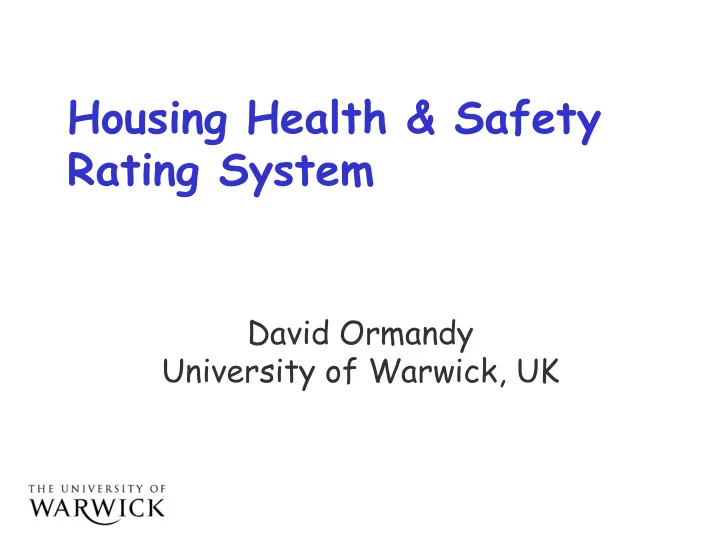

Housing Health & Safety Rating System David Ormandy University of Warwick, UK
HHSRS - What is it? • A risk-based approach for assessing housing conditions • In April 2006, introduced as the statutory method for assessing houses in England and Wales • In 2010, adopted by the US Department of Housing and Urban Development
The Fitness Standard (a) stability; (b) state of repair; (c) dampness; (d) provision for lighting, heating and ventilation; (e) supply of water; (f) facilities for the preparation and cooking of food; (g) a water closet, fixed bath (or shower) and wash hand basin; (i) drainage of foul, waste and surface water.
The Fitness Standard • Focuses on the building structure and facilities • Problems include ~ – Simple pass/fail model – Defects judged in terms of extent and cost of remedial works – Does not include all potential hazards
Probable Distribution of Unhealthy Housing in Stock Best CONDITION Worst Condition/risk A Fail B Pass C D 0 0 1.5 3 4.5 6 9 12 15 18 DWELLINGS IN STOCK (millions)
Principle behind Rating System A dwelling, including the structure and associated outbuildings and garden, yard and other amenity space, should provide a safe and healthy environment for the occupants and any visitors
Probable Distribution of Unhealthy Housing in Stock Best CONDITION Worst Condition/risk Rating 0
HHSRS Unique in several ways ~ 1. Does not set a ‘ standard ’ 2. Grades the severity of any threat to health and/or safety from the condition 3. Can include all potential housing hazards 4. Can apply to any form of dwelling, however constructed 5. Can be updated as knowledge increases 6. Provides a structured approach to assessment
Aims and Assumptions • Be evidence based • Focus on hazards (the threat to health) ie, the effect, not the defect • Rate the seriousness of any hazard • Be practical in its application
The HHSRS A. Physiological Requirements C. Protection Against Infection Damp and mould growth etc Domestic hygiene, Pests & Refuse Excessive cold Food Safety Excessive heat Personal Hygiene Sanitation & Drainage Asbestos (and MMF) Water supply Biocides CO & Fuel combustion products D. Protection Against Accidents Lead Falls associated with baths etc Radiation Falling on level surfaces Uncombusted fuel gas Falling on stairs and steps VOCs Falling between levels Electrical Hazards B. Psychological Requirements Fire Crowding and Space Flames, hot surfaces etc Entry by intruders Collision and entrapment Lighting Explosions Noise Position and operability of amenities etc Structural collapse and falling elements
The HHSRS Assessment Focuses on ~ • The potential health and/or safety hazards attributable to the design and/or construction, or lack of maintenance • The threat to a member of the age group vulnerable to that hazard Note ~ Initially, current occupiers (if any) and behavioural issues are disregarded
Stages in Assessment 1. Dwelling surveyed and any deficiencies recorded 2. Once survey completed, the surveyor attributes deficiencies to Hazards
Deficiencies? • The failure of an element to perform the function (or functions) it should perform • Whether that failure results from the original design or construction, or because of a lack of maintenance or repair
Deficiencies? To determine ‘ deficiencies ’ it is necessary to understand ~ a) the function(s) of each individual element of a dwelling (ie, what is its purpose?) b) what potential Hazard(s) could be caused by that element if it failed to fulfil those function(s) c) that it should fulfil the function(s) without creating another problem
Staircase in single family house
Staircase in single family house
Main Bedroom Main bedroom in single family house
Window in Child ’ s Bedroom Window to child ’ s bedroom in single family house
Refurbished kitchen in an apartment Cooking Stove in kitchen
Refurbished kitchen in an apartment Cooking Stove in kitchen
Stages in Assessment After attributing deficiencies to Hazards ~ 3. Surveyor ~ a) assesses the likelihood of a harmful occurrence b) the spread of outcomes from such an occurrence for each Hazard
Assessments under HHSRS • Scores are not aggregated • Result given in Bands to provide a ‘ Hazard Profile ’
Damp Collapse Cold 8 Ergonomics Heat 7 Explosions Asbestos 6 Collision Biocides 5 4 Flames etc Carbon Monoxide 3 Fire Lead 2 1 Electric Radiation 0 Falls - between Fuel Gas Falls - Stairs VOC Falls - level Crowding Falls - baths Entry Water Lighting Per. Hygiene Noise Food Safety Dom. Hygiene
HHSRS Score and Action HHSRS Score does not determine the appropriate action After HHSRS assessment, the surveyor determines the most appropriate action
Options for action • Enforcement ~ formal action requiring the owner to carry out remedial action to remove or minimise the Hazards • Financial Assistance ~ Grants, loans, or equity release (purchasing a share in the property)
Further information UK government web-site ~ https://www.gov.uk/government/publications/hhsrs-operating-guidance-housing- act-2004-guidance-about-inspections-and-assessment-of-hazards-given-under- section-9 US Department of Housing and Urban Development web-site ~ http://portal.hud.gov/hudportal/HUD?src=/program_offices/healthy_homes/hhrs
Recommend
More recommend